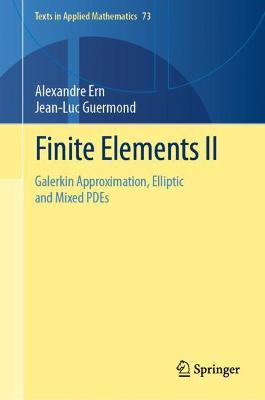Texts in Applied Mathematics
3 primary works
Book 72
This book is the first volume of a three-part textbook suitable for graduate coursework, professional engineering and academic research. It is also appropriate for graduate flipped classes. Each volume is divided into short chapters. Each chapter can be covered in one teaching unit and includes exercises as well as solutions available from a dedicated website. The salient ideas can be addressed during lecture, with the rest of the content assigned as reading material. To engage the reader, the text combines examples, basic ideas, rigorous proofs, and pointers to the literature to enhance scientific literacy.
Volume I is divided into 23 chapters plus two appendices on Banach and Hilbert spaces and on differential calculus. This volume focuses on the fundamental ideas regarding the construction of finite elements and their approximation properties. It addresses the all-purpose Lagrange finite elements, but also vector-valued finite elements that are crucial to approximate the divergence and the curl operators. In addition, it also presents and analyzes quasi-interpolation operators and local commuting projections. The volume starts with four chapters on functional analysis, which are packed with examples and counterexamples to familiarize the reader with the basic facts on Lebesgue integration and weak derivatives. Volume I also reviews important implementation aspects when either developing or using a finite element toolbox, including the orientation of meshes and the enumeration of the degrees of freedom.Book 73
This book is the second volume of a three-part textbook suitable for graduate coursework, professional engineering and academic research. It is also appropriate for graduate flipped classes. Each volume is divided into short chapters. Each chapter can be covered in one teaching unit and includes exercises as well as solutions available from a dedicated website. The salient ideas can be addressed during lecture, with the rest of the content assigned as reading material. To engage the reader, the text combines examples, basic ideas, rigorous proofs, and pointers to the literature to enhance scientific literacy.
Volume II is divided into 32 chapters plus one appendix. The first part of the volume focuses on the approximation of elliptic and mixed PDEs, beginning with fundamental results on well-posed weak formulations and their approximation by the Galerkin method. The material covered includes key results such as the BNB theorem based on inf-sup conditions, Cea's and Strang's lemmas, and the duality argument by Aubin and Nitsche. Important implementation aspects regarding quadratures, linear algebra, and assembling are also covered. The remainder of Volume II focuses on PDEs where a coercivity property is available. It investigates conforming and nonconforming approximation techniques (Galerkin, boundary penalty, Crouzeix-Raviart, discontinuous Galerkin, hybrid high-order methods). These techniques are applied to elliptic PDEs (diffusion, elasticity, the Helmholtz problem, Maxwell's equations), eigenvalue problems for elliptic PDEs, and PDEs in mixed form (Darcy and Stokes flows). Finally, the appendix addresses fundamental results on the surjectivity, bijectivity, and coercivity of linear operators in Banach spaces.
Book 74
This book is the third volume of a three-part textbook suitable for graduate coursework, professional engineering and academic research. It is also appropriate for graduate flipped classes. Each volume is divided into short chapters. Each chapter can be covered in one teaching unit and includes exercises as well as solutions available from a dedicated website. The salient ideas can be addressed during lecture, with the rest of the content assigned as reading material. To engage the reader, the text combines examples, basic ideas, rigorous proofs, and pointers to the literature to enhance scientific literacy.
Volume III is divided into 28 chapters. The first eight chapters focus on the symmetric positive systems of first-order PDEs called Friedrichs' systems. This part of the book presents a comprehensive and unified treatment of various stabilization techniques from the existing literature. It discusses applications to advection and advection-diffusion equations and various PDEs written in mixed form such as Darcy and Stokes flows and Maxwell's equations. The remainder of Volume III addresses time-dependent problems: parabolic equations (such as the heat equation), evolution equations without coercivity (Stokes flows, Friedrichs' systems), and nonlinear hyperbolic equations (scalar conservation equations, hyperbolic systems). It offers a fresh perspective on the analysis of well-known time-stepping methods. The last five chapters discuss the approximation of hyperbolic equations with finite elements. Here again a new perspective is proposed. These chapters should convince the reader that finite elements offer a good alternative to finite volumes to solve nonlinear conservation equations.

